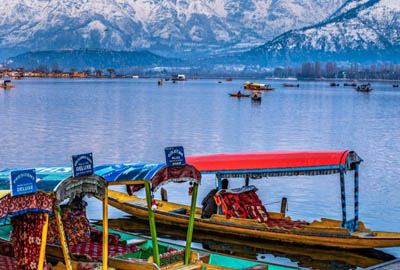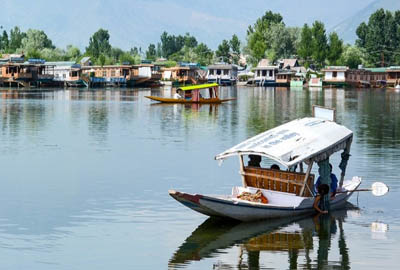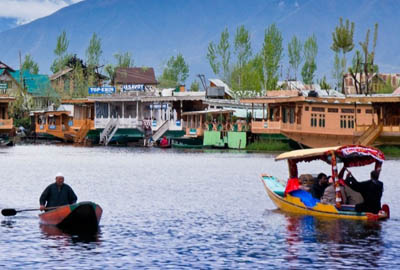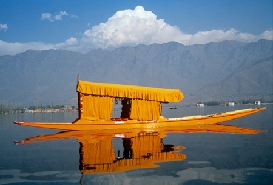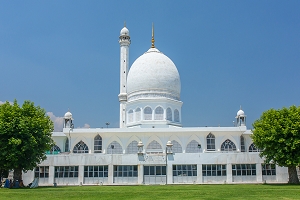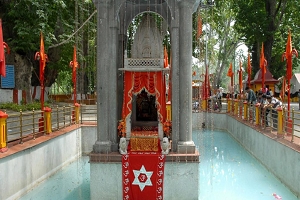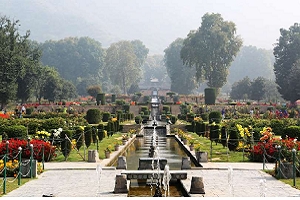Amid the lush grasslands of Srinagar, you can spot sacred shrines dedicated to different religions, depicting the unity in diversity. Some famous religious places in Srinagar are Hazratbal Shrine, Aali Masjid, Hamza Makhdoom, Kheer Bhawani, and Jama Masjid. Srinagar is blessed with natural beauty, scenic views, and tourist places. Moreover, the religious sites in Srinagar attract tourists and pilgrimage throughout the year.
You can find numerous places sacred sites in Srinagar where you can connect with spirituality and peace. Hazratbal Shrine is one of the most significant holy places in Kashmir and is beside the ever-famed Dal Lake. Another shrine a short distance is Gurudwara Chhati Pattshahi Sahib, which was built to commemorate the visit of the sixth master of Sikhs, Guru Hargobind Singh Ji.
Kheer Bhawani is an important Hindu Temple dedicated to Mata Kheer Bhawani, a form of Goddess Durga. Jamia Masjid is another important Islamic shrine in Srinagar. The mosque was built in 1400 AD and is known for its peace and tranquility. Different legends bind the faith of thousands of pilgrims who make their way to Srinagar in their quest for beauty and divinity.
Explore 6 days Amarnath Yatra package from Baltal by Helicopter, 6 days Kashmir Honeymoon package
List of Famous Religious Places in Srinagar You Must Visit
Shankaracharya Temple
One of the most revered Hindu pilgrimage destinations in Srinagar, the Shankaracharya Temple, is located atop a hill known as ‘Takht-e-Suleiman.’ The ancient temple stands about 1100 feet above the surface level of the main Srinagar city. Therefore, visiting this sacred temple involves a trek to the top of the hills.
Devoted to the worship of Lord Shiva, Shankaracharya Temple is believed to have been built by Raja Gopadatya in 371 BC. During those times, the temple was known as Gopadri. The great saint Shankaracharya is supposed to have stayed here when he visited Kashmir in the early part of the ninth century with the primary aim of spreading the philosophy of Vedanta. This perhaps led to the renaming of the temple as Shankaracharya Temple. Shankaracharya was also instrumental in popularizing the worship of Lord Shiva in Jammu and Kashmir.
Shankaracharya Temple is a monument of great significance, not only because of its religious importance but also for its architectural beauty. A high octagonal platform supports the temple structure, which is reached by a flight of around a hundred steps. The sidewalls of the steps are believed to have once bore valuable inscriptions. An inscription in Persian inside the Shankaracharya Temple dates back to the reign of Mughal Emperor Shahjahan.
Shankaracharya temple, as it stands today, has undergone several renovations in its lifetime. The first of these is believed to have been done during the rule of Lalitaditya. Later, more repair work was done by Zain-ul-Abideen, after the temple got damaged in an earthquake. As a result, the main surviving shrine of Shankaracharya Temple consists of a circular cell, providing a breathtaking view of the valley below. The inner chamber, after being renovated, is presently covered with a modern ceiling.
Check out Jammu and Kashmir Tour Packages, Gulmarg Tour Packages, Srinagar Tour Packages, Amarnath Yatra Packages
Hazratbal Shrine in Srinagar
The Hazratbal Shrine is a Muslim shrine on the left bank of the Dal Lake. The shrine is considered the holiest Muslim shrine in Kashmir valley. The shrine was built as a pleasure house by Sadiq Khan, Subedar of Shah Jahan. Later, the pleasure house was converted into a house of prayer with the orders of Shah Jahan. Today, the place is a well-known shrine that thousands of people visit every year. The Hazratbal Shrine takes its name from the Kashmiri language, where the word ‘Hazrat’ stands for holy, and ‘bal’ stands for the place. Therefore, the shrine is considered highly sacred among Muslims.
The Hazratbal Shrine is known as the epitome of love and respect of Muslims for their Prophet Mohammad. Visitors have a great view of Dal Lake and the mountains around. In addition, the shrine houses Moi-e-Muqqadus, the preserved sacred hair of Prophet Mohammad. The hair is presented before the public only on religious occasions. Visitors know the shrine by names, including Assar-e-Sharief, Madinat-us-Sani, and Dargah Shari.
The Hazratbal Mosque is a beautiful structure that is made using white marble. The mosque looks more beautiful with that stunning Himalayan mountain range in the backdrop. Also, the mosque features a great blend of Mughal and Kashmiri architectural styles, which were used during its construction back in the 17th century.
Chatti Padshahi in Srinagar
The Chatti Padshahi in Srinagar is one of the famous Gurudwara, which is not only one of the major tourist attractions of Srinagar but also an important place of worship for the Sikhs. Located in Rainawari in Srinagar, this is an important site for the Sikh devotees who assemble here to offer their prayers.
It is believed that the sixth Guru of Sikhs traveled throughout Kashmir, and wherever he preached, a Gurudwara was built, resulting in Chatti Padshahi Gurudwara in Srinagar. Situated on the southern gate of Hari Parbat Fort, this is an important Gurudwara of the Sikh community. There are also many Sikh Gurudwaras in Jammu and Kashmir, but devotees mostly visit Chatti Padshahi.
- How to Reach Chatti Padshahi in Srinagar: It is located near Kathi Darwaza in Rainawari on the southern gate of Hari Parbat Fort.
- Nearest Airport: You can drop into the Srinagar Airport and then reach Chatti Padshahi by driving.
- Nearest Railhead: Jammu Railway Station is the nearest railhead, 305km from Srinagar.
- Roadways: Srinagar is interconnected with a good number of roadways to the rest of the city.
Khanqah-e-Molla
The Khanqah-e-Molla or Shah-e-Hamdan is one of the oldest Muslim shrines on the banks of the river Jhelum in Srinagar city. An important religious destination in Srinagar, this shrine was originally built in 1395 and later reconstructed in 1732. Believed to contain “the secret of Allah,” – the Khanqah-e-Molla is an excellent example of wood architecture that draws inspiration from Buddhist, Hindu, and Islamic styles. Khanqah-e-Molla was initially constructed by Sultan Sikander (1389-1413 AD) in memory of Sufi saint Mir Syed Ali Hamdan, who stayed in Kashmir and was instrumental in the spread of Islam in Kashmir.
Khanqah-e-Molla was ravaged by fire in 1480 and reconstructed by Sultan Hassan Shah in 1493. Again in 1731, the shrine got damaged, but Abul Barkat Khan rebuilt it in 1731. Khanqah-e-Molla, as it stands today, has a square plan erected on an irregular walled base of materials from ancient temples. The two-storied, two-tiered structure of the shrine has gently sloping pyramidal roofs demarcating each tier. Heavy woodwork adorning the cornices under the eaves further accentuates the roofs.
The first tier features double-arcaded verandahs that run continuously around the building. The second tier is an arcaded balcony protruding on all four sides of the main building. An open pavilion tops the pyramidal roof of the second tier for the muezzin, which is further crowned by a pyramidal spire. Parts of the roof are covered with seasonal vegetation, creating a unique sight of intricate woodwork and terraced flowerbeds. The saint’s shrine at Khanqah-e-Molla lies in a cloister at the northwest corner of the structure. A date -1384 AD, marking the saint’s death, is carved above the doorway.
Kheer Bhawani Temple
The Kheer Bhawani Temple in Srinagar is one of the important places of worship in Kashmir. The Kheer Bhawani Temple is associated with Ragnya Devi and is located in Tulamula in Srinagar. An important Hindu shrine is visited by many Hindu pilgrims on Jesht Ashtami when the annual festival is held. Established by Maharaja Pratap Singh in 1912, Kheer Bhawani Temple is one of the historical monuments of Srinagar. Through all these years, the age-old temple has suffered the vagaries of time. It was also renovated during the reign of Hari Singh.
Browse through our Amarnath yatra packages from Vadodara, Amarnath yatra tour packages from Chennai, Kashmir Tour Packages from Kolkata, Kashmir Tour Packages from Bangalore
History of Kheer Bhawani Temple:
Located amidst the beautiful Chinar trees and rippling rivers lies the Kheer Bhawani Temple, Goddess Ragnya Devi’s abode. The idol is kept in a white marble temple. According to Hindu mythology, Lord Rama worshipped Ragnya Devi during his exile. After the exile was over, he shifted her abode to Shadipora, from where it was moved here according to the wish of Ragnya Devi. There is a beautiful spring located near the temple.
- Location: It is located in the Ganderbal Tehsil of Srinagar which is 27km from the main city.
- Nearest Airport: Srinagar Airport
- Nearest Railhead: Jammu Railway Station
- Festivals of Khir Bhawani Temple: An annual festival is held during the Jesth Ashtami, and Hindu devotees visit the Kheer Bhawani Temple during this time. On the eighth day of the full moon in May, pilgrims assemble here and celebrate the occasion. It is also believed that the Goddess Ragnya Devi changes the color of the spring’s water during this time.
There are many religious places to visit in Srinagar where you can take a spiritual journey. You can also make your tour more enticing by planning a holiday through our tour packages of Srinagar.



